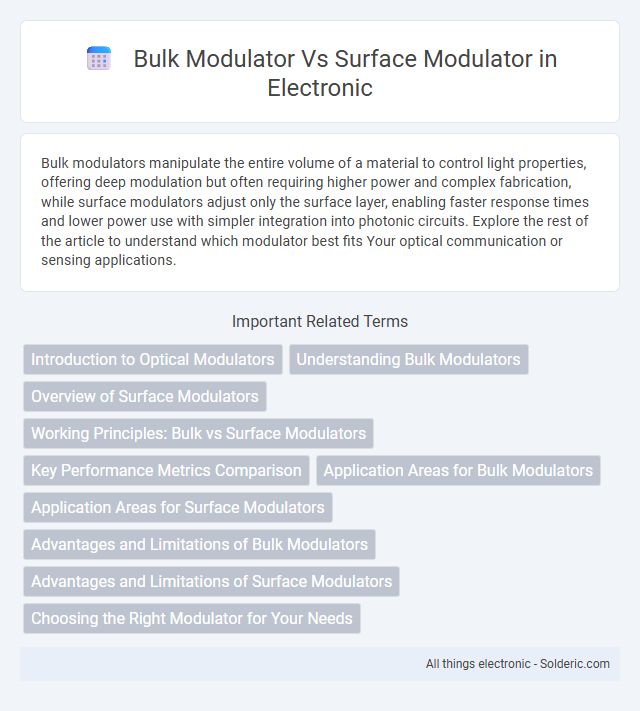Bulk modulators manipulate the entire volume of a material to control light properties, offering deep modulation but often requiring higher power and complex fabrication, while surface modulators adjust only the surface layer, enabling faster response times and lower power use with simpler integration into photonic circuits. Explore the rest of the article to understand which modulator best fits Your optical communication or sensing applications.
Comparison Table
| Feature | Bulk Modulator | Surface Modulator |
|---|---|---|
| Operating Principle | Modulates light through changes in the bulk refractive index. | Modulates light via surface refractive index or absorption changes. |
| Modulation Speed | Generally slower due to volume-based interaction. | Faster response due to surface confinement. |
| Integration | Bulkier, less suitable for compact photonic circuits. | Highly compatible with integrated photonics and nanophotonics. |
| Insertion Loss | Potentially higher due to internal absorption and scattering. | Lower insertion loss from surface-confined modulation. |
| Fabrication Complexity | Relatively simpler fabrication processes. | Requires precise surface engineering and nanofabrication. |
| Applications | Bulk optical modulators, fiber optics, traditional photonics. | Integrated photonic circuits, optical switches, modulators in high-speed communication. |
Introduction to Optical Modulators
Optical modulators control the intensity, phase, or polarization of light beams in optical communication systems, with bulk modulators utilizing entire crystal volumes to modulate light and surface modulators employing thin-film or waveguide structures for precise modulation. Bulk modulators offer high power handling and broad spectral response, while surface modulators provide faster response times and better integration with photonic circuits. Understanding these distinctions helps you select the right modulator type for optimizing signal quality and system performance in applications like fiber-optic communication and laser systems.
Understanding Bulk Modulators
Bulk modulators operate by changing the refractive index of the entire semiconductor material through the injection or depletion of charge carriers, resulting in phase or amplitude modulation of the optical signal. In contrast, surface modulators confine the modulation effect to a thin region near the device surface, leading to faster response times but typically lower modulation efficiency. Understanding bulk modulators involves analyzing carrier dynamics in the volume of the device, which crucially impacts modulation depth and insertion loss in optical communication systems.
Overview of Surface Modulators
Surface modulators manipulate the refractive index at the interface of semiconductor materials, enabling precise control of light propagation in photonic devices. They offer faster modulation speeds and lower power consumption compared to bulk modulators, making them ideal for high-performance optical communication systems. Your choice of a surface modulator can enhance device integration and improve overall signal quality in advanced photonic circuits.
Working Principles: Bulk vs Surface Modulators
Bulk modulators operate by exploiting the electro-optic effect within the volume of the substrate material, causing a refractive index change that modulates the light passing through the entire bulk medium. Surface modulators, on the other hand, manipulate light through interactions confined near the surface, often utilizing surface acoustic waves or carrier injection to alter the optical properties at or near the interface. The fundamental difference in working principles lies in the modulation region--bulk modulators affect the entire propagation path inside the material, while surface modulators restrict modulation effects to a thin surface layer.
Key Performance Metrics Comparison
Bulk modulators typically offer higher modulation efficiency due to a larger interaction volume with the optical signal, resulting in lower voltage-length (VpL) product compared to surface modulators. Surface modulators excel in bandwidth performance, often achieving modulation speeds exceeding tens of GHz, benefiting from reduced capacitance and faster carrier dynamics. Power consumption in bulk modulators tends to be higher owing to increased drive voltages, while surface modulators provide enhanced energy efficiency crucial for high-speed optical communication systems.
Application Areas for Bulk Modulators
Bulk modulators are predominantly used in fiber optic communication systems, leveraging their high-speed modulation capabilities for long-distance data transmission and high-capacity networks. They are ideal for applications in telecommunication infrastructure, data centers, and advanced sensing technologies where maintaining signal integrity over extended distances is crucial. Your choice of a bulk modulator ensures enhanced performance in environments demanding high bandwidth and low signal distortion.
Application Areas for Surface Modulators
Surface modulators are predominantly used in photonics and optoelectronics, particularly in applications requiring precise light modulation such as optical switches and modulators in fiber-optic communication systems. Their ability to manipulate surface plasmon polaritons enables enhanced sensitivity in biosensing and improved performance in integrated photonic circuits. These modulators offer superior speed and miniaturization advantages over bulk modulators, making them ideal for advanced telecommunications and on-chip optical signal processing.
Advantages and Limitations of Bulk Modulators
Bulk modulators offer higher modulation efficiency and lower insertion loss compared to surface modulators, making them ideal for high-power and long-distance optical communication systems. Their advantages include larger mode size and better thermal stability, which reduce signal distortion and improve reliability. However, bulk modulators tend to be bulkier, more expensive, and less compatible with integrated photonic circuits, limiting their use in compact or cost-sensitive applications.
Advantages and Limitations of Surface Modulators
Surface modulators offer improved modulation efficiency and faster response times compared to bulk modulators, making them ideal for high-speed optical communication systems. They enable compact device design with lower driving voltages, reducing power consumption and integration complexity. However, surface modulators typically face challenges like limited modulation depth and increased sensitivity to fabrication imperfections, which can impact device performance and reliability.
Choosing the Right Modulator for Your Needs
Bulk modulators offer high bandwidth and efficient integration for applications requiring deep modulation depths and fast response times, making them ideal for high-speed optical communication systems. Surface modulators provide compact size and low driving voltage, suited for densely integrated photonic circuits where minimizing power consumption and device footprint is critical. Evaluate your system's bandwidth, power efficiency, and integration requirements carefully to choose the right modulator that optimally meets your performance and design goals.
Bulk modulator vs surface modulator Infographic

 solderic.com
solderic.com